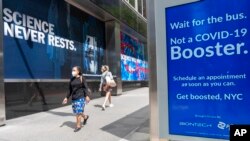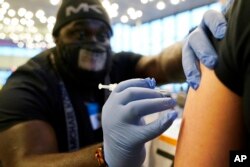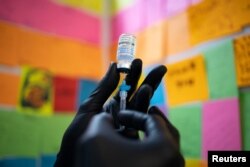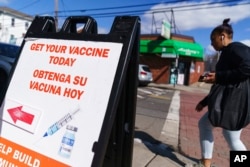For weeks, reformulated bivalent COVID-19 vaccine boosters have been available across the United States that aim to protect against newer omicron variants that have sickened millions of people in recent months.
Initial reports, however, suggest Americans are not rushing to get the new vaccines.
While health officials view this as a challenge, some say a drop-off in demand shouldn't be surprising.
"Back in late 2020 and early 2021 when the vaccine first became available, many Americans were afraid for their life of this virus," said Paul Offit, director of the Vaccine Education Center at Children's Hospital of Philadelphia.
"We were all susceptible to serious illness then. Today, most Americans feel safer, and we've got tens of thousands of people screaming in stadiums together at football games. The situation feels different, so it makes sense there's less urgency to get vaccinated," Offit told VOA.
Still, the Food and Drug Administration is encouraging people ages 12 and older to get the bivalent booster. In deciding to authorize them, the FDA pointed to data from earlier iterations of COVID-19 vaccines as evidence the bivalent vaccine is safe and will provide additional protection from the most severe symptoms of both the original and more recent coronavirus strains.
In a recent press release, FDA commissioner Robert Califf said, "The COVID-19 vaccines, including boosters, continue to save countless lives and prevent the most serious outcomes [hospitalization and death] of COVID-19.
"As we head into fall and begin to spend more time indoors, we strongly encourage anyone eligible to consider receiving a booster dose with a bivalent COVID-19 vaccine to provide better protection against currently circulating variants."
Supply exceeding demand
The United Kingdom was the first country to make the bivalent vaccine booster available, doing so in mid-August. After the United States and Canada, the European Union could be next. Earlier this month, the European Medicines Agency (EMC) recommended approving revamped boosters to all 27 EU member states – something that could happen within days.
As of last week, more than 25 million doses of the updated vaccine had been delivered to tens of thousands of sites across the United States, from pharmacies to medical facilities to local government venues operating vaccination sites.
Yet, while more than 80% of the U.S. population has gotten a COVID-19 vaccine since they became publicly available in early 2021, the U.S. Centers for Disease Control and Prevention released data last week estimating that just 4.4 million people — approximately 1.5% of the population — had received the bivalent vaccine.
While appointments at vaccination sites were often booked weeks in advance in early 2021, demand for the new booster is low enough that many vaccine providers can accept walk-ins.
Dani Streger, a teacher from Brevard County, Florida, said she got the original vaccine in 2021 but doesn't see a need to get the bivalent shot.
"I've already had COVID, and it wasn't severe," Streger told VOA. "People can do whatever they want, but I'm not a high-risk individual, and the bivalent booster seems unnecessary for me at this point."
While national data paint an overall picture of weak demand, health officials in some states insist plenty of people are eager to get the vaccine.
"We're still coming down from our sixth and longest-enduring [COVID] surge to date," Louisiana Department of Health public information officer Mindy Faciane told VOA. "Many Louisianians recently had COVID-19, and there's still high transmission across the state. Many of our residents had been anxiously awaiting an updated booster shot."
Who to target?
Coronavirus transmission in the United States reached a summer peak of 227,000 cases reported in a single day in July. Documented transmission has significantly ebbed since then, although many cases go unreported. Significantly, deaths blamed on COVID-19 have hovered between 300 and 500 per day since April — down from daily averages that topped 3,000 at the peak of the pandemic.
This has left many Americans and even some health experts in disagreement over the importance of the bivalent booster shot.
Offit said he believes the CDC's recommendation that anyone over age 12 receive the vaccine is unnecessary.
"The best any coronavirus vaccine can do is stop individuals from experiencing severe, dangerous symptoms," said Offit, who serves on the FDA Vaccine Advisory Committee and voted against authorizing the bivalent vaccine. "But the already available regimen of vaccines and boosters already does that for most of us."
The exceptions, Offit explained, are the elderly, those with serious health problems and people who are immunocompromised.
"Heading into the fall and winter, when diseases like coronavirus and the flu are at their worst, the focus should be on getting the bivalent vaccine to these at-risk groups who will really benefit," he said.
For those not in at-risk groups, Offit said getting additional boosters can be a personal choice. Additional data on the protection provided by the new booster likely won't be released for weeks, but the limited early research suggests the updated vaccines provide only a modest level of additional protection for those who are already vaccinated and healthy.
"If you've had several doses of the vaccine, and maybe you've had COVID and developed antibodies that way, then your resistance is already high," Offit told VOA. "The amount another dose can help you is minimal … so I think these bivalent boosters become a personal choice."
Spectrum of opinions
National, state and local health agencies agree that high-risk groups should be prioritized. But the vast majority are urging the public at large to get the bivalent shot.
Jennifer Avegno, director of the New Orleans Health Department, remembers what it was like during the pandemic's early days, when hospitals were overwhelmed and without enough beds to care for patients.
"Nationally, around 400 individuals per day continue to die from COVID — a stark reminder that many are still at high risk," she told VOA. "As we head into the winter, where respiratory disease generally increases, we cannot afford to strain our hospitals as we have in previous years.
"We know that well-matched vaccines give significant protection against hospitalization, severe disease and death, and so to preserve health care capacity, reduce work disruptions and protect our most vulnerable, everyone is urged to get the booster and a flu vaccine as soon as they are eligible."
Across the country, Americans are deciding for themselves.
In Uintah County, Utah, for example, high school teacher Jason Winder told VOA he won't be getting the updated booster and believes pandemic fatigue has set in for many.
"We've been talking about the coronavirus for more than two years, and I think people are tired of it," he said. "Not that it's not important, but I think that's why so few people here are getting the bivalent booster so far."
Winder added, "For me, I got the initial vaccine and a booster because my job would have made me stay home and use my paid time off if I tested positive for COVID, even if I was asymptomatic. That rule is no longer in place, so I'm not worried about it anymore after all these doses of vaccine I've already had."
Other Americans remain eager to receive any new dose of vaccine to feel maximally protected.
Aaron Scheibelhut, a freelance sports broadcaster who also owns a filming company in Indianapolis, Indiana, said even though he noticed this dose didn't seem to have been advertised as much, receiving the bivalent booster was still a priority for him.
"Because I work for myself, I don't get paid time off. I didn't want to risk it," he said. "Plus, I already got COVID once, and I didn't want to go through that again."
With coronavirus case numbers expected to rise in the coming months, local health departments are doing their best to raise public awareness about the bivalent vaccine booster.
In New Orleans, like many other locations, Avegno said there is a focus on at-risk groups.
"We're utilizing community health workers to communicate with those key groups and to get the word out, and we're planning vaccine events with community partners close to higher concentrations of vulnerable individuals," she said. "Much of our communication campaigns are focused on targeting those at-risk groups where we'll see the biggest public health benefits."













